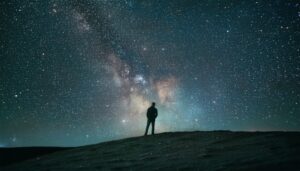
We’ve received many inquiries regarding the topic of remote viewing—specifically how this particular method allows for a kind of time travel to the past through non-ordinary perception. To address the most common questions, we’ve compiled this comprehensive article explaining how our specialized remote viewing process works.
Note: All procedures described here are tailored to one specific viewer, optimized and refined over time to suit his capabilities.
This viewer, who prefers to remain anonymous, is known under the pseudonym Ezekiel.
The Setting: Preparing for the Session
Ezekiel enters a specially prepared room designed solely for remote viewing. The environment is quiet, controlled, and minimalist to eliminate all distractions. Depending on the session, the room contains either an air mattress or a flat mat, allowing for comfortable, prolonged stillness.
Prior to beginning the session, the remote viewer spends time focusing intensely on a reference object. This might be a photograph, a short video clip, or a historical artifact. The item serves as a mental anchor or “trigger” for the journey and is carefully memorized beforehand.
The Induction: Entering the State
The remote viewer lies flat on his back, either on the mat or the airbed. Using headphones, he listens to a rhythmic drumbeat. This sound was previously recorded by Ezekiel himself, ensuring it resonates personally with him. The purpose of the drum rhythm is to guide the body and mind into a deep state of relaxation. It’s a highly individualized method, customized to help the viewer disconnect from everyday awareness.
As the session begins, Ezekiel actively works to silence his internal thoughts—especially those shaped by personal memories or experiences. He refers to this process as “engaging the autopilot”—a mental state where his consciousness begins to detach from the conscious mind, similar to entering a dreamlike phase.
Eventually, he slips into what he describes as a dream phase without awareness, comparable to sleep. A state of sleep paralysis often sets in—his body becomes immobile, although his consciousness remains alert in a new kind of way.
The Transition: Entering the Scene
According to Ezekiel, this is the moment of breakthrough. He reports experiencing a sensation of incredible acceleration and a blinding inner light. Then, suddenly, he “wakes up” in a new scenario—directly connected to the original reference material.
This moment marks the crossing of a threshold, a rupture in perceived time and space.
Biological Aspects
Interestingly, during this phase, the concentration of DMT (Dimethyltryptamine)—a powerful, naturally occurring compound in the brain—is reported to increase dramatically. This happens without any external chemical being introduced into the body. It appears to be a spontaneous release, likely triggered by the deep altered state Ezekiel enters.
The Experience: Awareness in the Past
Once “on the other side,” Ezekiel can move freely and observe events. He remains conscious within the dream, yet it’s not a lucid dream in the traditional sense. While he can navigate through the environment in three-dimensional space, he cannot change the events or interact with people. He can only observe—and even then, only from a position the experience allows.
Importantly, he has no control over the specific point in time he reaches. The reference item determines the scenario but not the exact date or moment in history. For example:
- If one uses a location tied to a historical event (such as Golgotha in Jerusalem), the viewer might arrive in any of several eras—possibly the Iron Age or even modern times.
- A physical artifact, such as the tip of a spear believed to be involved in an ancient battle, may serve as a stronger reference. In such cases, the viewer can sometimes access associated memories of people who came into contact with the object, especially if the emotional imprint was strong.
This form of remote viewing enables access to shared memory fields—residual emotional and perceptual imprints surrounding significant artifacts or events.
After the Session
When the session ends, the viewer often reports having lost all sense of time. Although it feels like 30 minutes to several hours may have passed, in reality, only 2 to 4 minutes have elapsed.
Immediately afterward, Ezekiel produces sketches and written protocols documenting everything he perceived. This process is critical to capturing details before they fade from memory.
Side Effects
While this technique can yield profound insights, it is not without minor physical aftereffects:
- A mild pressure sensation around the temples and just above/behind the ears.
- Occasional numbness.
- In rare cases, lingering mild pain within the inner ear.
- Temporary fatigue following sessions, often described as mental exhaustion.
For further insights into Ezekiel’s work and remote viewing philosophy, we invite you to explore these additional resources:
This unique form of remote viewing blurs the boundaries between perception, memory, consciousness, and time. It’s not a mechanical process, but a deeply intuitive and bio-spiritual one—one that pushes the limits of human experience and understanding.
If you have further questions or would like to share your own experiences, feel free to reach out.




